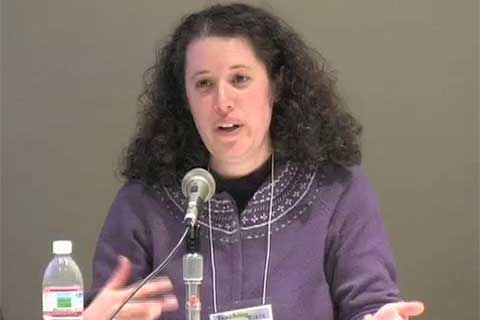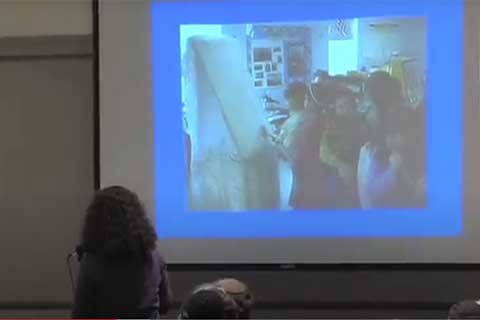Creating a Community of Torah Learners
This case, about Shira Horowitz's teaching at South Area Solomon Schechter Day School in Stoughton, MA, explores the question, "How can I teach Torah to young children in a way that respects the integrity of the text and the developmental and individual needs of my students?"
In my classroom, I try to teach Torah to kindergartners and first graders in a way that allows me to share my passion for the text and also allows me to hear my students’ voices. While the Torah is certainly a difficult text, it is one which is integral to our identity and education as Jews. I feel a tremendous, awesome responsibility to take this text seriously and share it in an authentic way. At the same time, I am committed to doing all I can to meet the developmental and individual needs of my young students.
Developmentally, the text of the Torah is challenging for young children. The written text is not yet accessible to them because of their reading level, and even when read aloud, the language is often above their comprehension level. Beyond the language, the text deals with abstract themes, difficult concepts and sophisticated topics.
Yet, this text is also filled with stories and ideas dealing with many of the same questions that children wonder about: How was the world created? What is a family? What are right and wrong ways to act with other people? What do we know about God? Given the opportunity, children often ask questions that are deep and philosophical, the type that adults often shy away from. They wonder about the world and think about big, difficult ideas. Studying Torah gives them a place to explore these ideas and express these thoughts.
In Jewish tradition, Torah learning is not only an individual act. With practice, young students can also learn to “talk Torah” with each other as members of a community. They can learn to listen as well as respond, as they relate one part of text to another and ask each other interesting, challenging questions. Given the right support and structures, Torah learning can truly be lifelong learning, beginning at the earliest ages of school.
Some of The Thinking Behind My Teaching Practice
Expand All
- Content knowledge – what happened, who are the characters, what do the words say? I want my students to be able to understand and retell this text much as they would any other literary text. I want them to learn the details and the overall ideas. I want them to make connections to their own experiences, to visualize images to match the words, and to ask questions as they read.
- Jewish identity and personal connection – I want my students to connect to this text at a more personal level. I want them to take these stories and make them their own. I want them to see the story of Bnei Yisrael as OUR story, the story of our family and our land, connecting each one of us to the greater Jewish community and the land of Israel.
- Lessons for living – I want my students to make connections between Torah and their own lives. I want them to use Biblical characters as models for Jewish values, from Avraham’s hospitality to Rivka’s kindness to animals. I want them to see the Torah as a source for rules that we still follow today, from Shabbat to kashrut.
- Love of Torah – I want my students to develop a love and respect for the Torah itself and to place it in a greater context outside of our classroom. I want them to approach this text with a sense of kedusha, of holiness. I want my students to feel emotionally connected to Torah, to love hearing Torah stories and discussing ideas from Torah. I want them to share this love of Torah with each other, with their families, and with others in the school.
The decision to teach parshat hashavua rather than teaching selected Torah stories at our own pace brings with it many challenges. We cannot possibly teach everything in every parasha. Some weeks, we must rush through or skip sections filled with wonderful stories, while other weeks we must struggle to find anything that seems relevant to young children.
What we gain from a curriculum based in parshat hashavua is a continuity, a sense of community, and an attachment to the place of Torah within our Jewish world. Students learn the cycle of the Jewish year and become part of it. They learn that “this week’s parasha” in our classroom is the same as this week’s parasha throughout our school, in their synagogues, in Israel, and throughout the world. They learn that these stories and texts are so important to us that we read them over and over again. We cycle back through the same parshiot each year, remembering the details we’ve learned before and looking for new meanings and new relevance to our lives.
I believe that much of the power in the methods that I use to teach Torah lies in the consistent, predictable structure. Just like a writing workshop or a reading workshop in which children come to expect certain beginnings, time to do certain kinds of work, and certain kinds of endings, Torah time in my classroom is based on a particular structure with four major components. While the conversation, the acting, and the writing may all look different from the beginning of the year to the end, it is the very predictability of the structure that allows the students to evolve in this way. Rather than being confining, as I once worried it might be, I have come to see the predictable structure of Torah lessons in my classroom as a scaffold to help students succeed, be creative and interact with the difficult work of Torah study.
My approach to teaching Torah originally stemmed from an interest in integrating my teaching of Torah with the teaching of early literacy which is so central to the early grades in school. I want my students to learn Torah for its own sake and appreciate its unique place in our tradition. At the same time, this approach to teaching Torah helps to build students’ language skills in listening to stories, making sense of stories and responding to them, and using writing and drawing as ways to record their thoughts. It also uses what we know from literacy teaching, including reading response approaches and journal writing, to enhance students’ understanding as they learn Torah.
I started with several assumptions about literacy which I continue to hold today.
- First, oral language is an important skill for young children. Long before they can express their ideas through writing, children have so much to say. As teachers, we need to make sure that children have the opportunity to express themselves through talk, both for the sake of oral language development and as a rehearsal for their writing.
- Second, children need to learn to respond to texts that they hear or read. Reading (or listening to a story) is a process of making meaning, in which the reader (or listener) interacts with the text. When children hear or read a text, they should be able to retell it, to respond to parts they like, or to make a personal connection. They should be able to ask questions of the text. These kinds of responses can happen in oral discussions, and they can also take place in response journals. Both the talk and the writing are useful tools for making sense of the text. When we allow children to share their ideas about big and important themes such as those found throughout the Torah, we will find much worth listening to.
- Third, children just learning to write can begin to learn to use written expression as a way to record their ideas. When we offer them a journal to record their ideas, we broaden our ideas about their “writing” to include talk, drawing, and writing. Often this writing can offer us a window into children’s thinking beyond what they might tell us.
- Finally, speaking, listening, reading and writing are all important literacy skills which children can use across the curriculum. If children spend time writing in a Torah journal, they will practice important writing skills that will transfer to other times of the day. If children practice responding to stories in the context of Torah, this will enhance their ability to understand and respond to other books. Therefore, a literacy-based Torah curriculum does not “take away” from time spent on other areas; in fact, it only enhances it.
In addition to these assumptions about literacy, I also began with some assumptions about children and Torah.
Children wonder about their world and often think about big, difficult ideas. Given the opportunity, children will ask questions that are often deep and philosophical, the type that adults often shy away from. While the Torah is certainly a difficult text for young children, it is one which is integral to our identity and education as Jews. It is also filled with stories and ideas about many of the same questions that children wonder about: How was the world created? What is a family? What are right and wrong ways to act with other people? What do we know about God? Given the right support and structures, Torah learning can truly be lifelong learning, beginning at the earliest ages of school.
With these assumptions in mind, I began to develop a routine that I called “Torah Talk and Torah journals.” While I have refined my teaching and broadened my methods, I continue to use the basic techniques of allowing children to respond to Torah in talk and in writing through a structured approach.
Reflections on Teaching Torah to Young Children
Click the thumbnail image below to watch the video.




